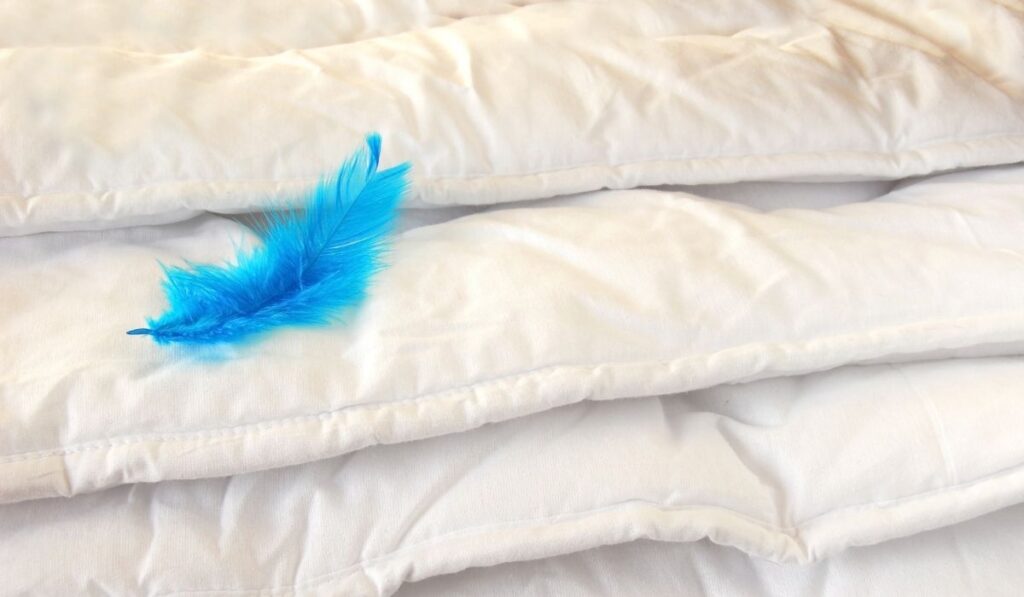Wrinkles naturally form on new comforters because they’ve been stored in a compact space for a long time. Other wrinkles may form due to the usual humidity and heat. So what can you do to free your new comforter of these pesky wrinkles?
You can wash the comforter in a high-capacity washer and then add clean tennis balls during the drying cycle to remove wrinkles. You can also spray the fabric with a light mist and allow it to dry for 10 minutes to remove some wrinkles. Return the comforter to its usual position right after drying.
To effectively get wrinkles out of a new comforter, you can use anti-wrinkle spray, softener, dryer balls or tennis balls, a steamer, and more. Let’s take a look at all of your options so that you can have a comfortable, wrinkle-free comforter on your bed.
How Do You Remove Wrinkles From a New Comforter?

Wrinkles happen no matter what material the comforter is made of, and they can appear right out of the package before you’ve even used it. If the comforter is new and machine washable, follow the care tag’s instructions to remove any chemicals from the fabric before use.
If the item isn’t machine washable or has recently been washed, a gentle spritz of water and a low- or no-heat tumble in the dryer should remove the wrinkles.
Use a Washer With a Large Capacity
To freshen and remove creases from a new comforter, wash it, preferably with a high-capacity washer. Comforters can be quite large, and they need room to move around.
Wash the comforter according to the care tag’s directions, using enough laundry detergent to handle a medium-sized load. After the final rinse, use an extra spin cycle to get rid of any remaining water.
To help prevent wrinkles, remove the blanket as soon as the final spin cycle finishes. To release more creases, gently shake it out.
During the drying cycle, you can also add a few clean tennis balls. Your comforter will remain fluffy with the use of dryer balls or tennis balls.
Using a low-heat setting, dry the comforter according to the care tag’s instructions.
Check the comforter every 30 minutes; a synthetic comforter may take less than an hour to dry; however, a down comforter may take much longer, especially if you are using no heat. To avoid clumps and wrinkles, fluff up a down comforter whenever you check it.
Wrinkles will occur if the comforter is not withdrawn from the dryer quickly enough. If it’s not completely dry, hang it to dry or put it in the dryer again. Return the dry comforter to its original position on the bed, or fold it neatly for storage.
Spray the Fabric With a Light Mist
If you don’t want or need to wash your comforter, you can also use this alternative technique.
Using a spray bottle, add a few drops of water to your comforter. Spray a light mist of water over the wrinkled comforter, just enough to dampen it, but not completely. Dry the comforter on the lowest heat setting in a large capacity dryer. If the comforter is down, fluff it up with a couple of dryer balls or clean tennis balls.
After 10 minutes, remove the comforter. If the comforter is still wrinkled, spritz it with some more water and examine it again in 5 to 10 minutes, removing it as soon as possible to avoid further wrinkling. Place the comforter on the bed or fold it neatly to store it while it is still wrinkle-free; storing it in a cloth basket will develop wrinkles.
Things You’ll Need
- Anti-wrinkle spray (on Amazon)
- Softener for textiles (on Amazon)
- Rubbing alcohol
- Water that has been distilled
- A spray bottle
- A hairdryer
- A washing machine and dryer
- Tennis balls or dryer balls
- Wet clothes or ice cubes
How Do You Get Wrinkles Out of Cotton Bedding?

Pure cotton sheets are prone to creases, especially when they’re fresh. Hotel sheets are often made of cotton and polyester, so they’re less wrinkly but lack the smooth feel of cotton percale sheets. So, what are your options?
The best method to keep your linens wrinkle-free is to prevent them from wrinkling in the first place. Be sure to untangle sheets before placing them in the washing machine. Don’t overwork the washing machine or dryer. They become wrinkly when they are squished!
One sheet at a time would be ideal, but you’d be doing laundry for the rest of your life. One sheet set at a time is a more realistic choice. When washing and drying, use low temperatures to avoid creases.
Wash regularly
The best sheets are crisp, clean ones. Sheets should be washed every week, ideally, because they absorb body oils and dust at a rapid rate. However, washing has another advantage: It reduces wrinkles. This is because pure cotton sheets, like ours, are constructed of very fine, long-staple fibers that are stiff at first but soften with repeated washing. As a result, your sheets become softer and less prone to wrinkling.
Dry
The way you dry your sheets is very important. It’s best to air-dry your sheets — not just because of the feel but also because the scent of freshly dried sheets is unrivaled. Hanging sheets on the line allows them to hang smooth and flat, and the weight of the water in them means gravity takes care of a lot of the wrinkle removal.
Tumble dry on low heat if air drying isn’t a possibility. Remove them from the dryer while they’re still damp and place them right back on the bed for optimal effects. They’ll dry rapidly and virtually completely wrinkle-free!
No matter the method you use to dry your sheets, make sure you don’t leave them there for too long once they’re done. Abandoning your sheets in a crumpled, soggy stack is a sure way to get more wrinkles.
Steam
The clothing steamer uses an unparalleled mix of heat and water to destroy wrinkles. Because sheets are much larger than clothes, they will need to be folded once or twice before being hung, so they are nice and flat and easy to run the steamer wand over. Then, the creases on your bedding will vanish in virtually no time.
Spray
If you don’t have a steamer, don’t worry. Make sure the fitted sheet is taut and secure on the bed. The pressure, along with simple water, helps in the reduction of wrinkles. Set a spray bottle to mist and lightly spray the entire sheet, including the sides. Please don’t overdo it; the goal is to mildly dampen the sheet, not to drench the bed.
Run your hand across the creases to smooth them out, then set the sheet aside to dry. Then repeat with a flat sheet tucked on top. It’s best to do this first thing in the morning so the sheets have plenty of time to dry. This procedure may not be as effective as a steam treatment, but wrinkles and creases should be reduced considerably.
